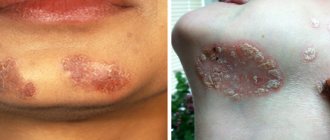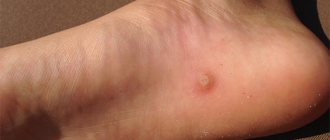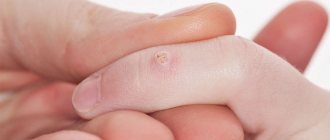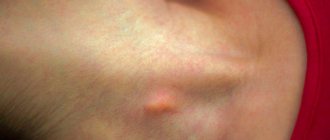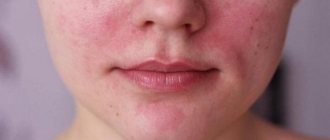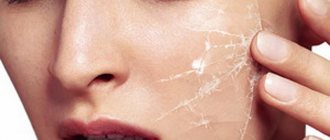The appearance of scabs on the penis, covering rashes, is a very pressing problem for modern men.
Firstly, this pathology is caused by many diseases, sometimes very contagious.
We will specify which ones a little later, within the boundaries of this article.
Secondly, such scabs can be very painful or simply cause a lot of discomfort to their owners.
Thirdly, even if their appearance is practically asymptomatic, it is still necessary to establish the cause of their appearance and get rid of them as quickly as possible.
The presence of any rash on the penis is a reason to treat the pathology with attention and immediately seek medical help.
But practice shows that not every man sees a doctor on time.
Many people delay examination by a dermatovenerologist and ask for help at an advanced stage of the disease.
A healthy penis has a pale pink color and a smooth surface, without rashes or crusts.
Any deviation from this indicator is already a pathology and a reason to consult a doctor.
The main thing is to trust a specialist and not engage in self-diagnosis and self-medication.
This is fraught with many complications.
Let the doctor take care of your health.
Scab on the head of the penis
The appearance of a scab on the head of the penis is often accompanied by itching in the entire groin area.
It is necessary not only to see a specialist, but also to do all the necessary tests.
Only by establishing the correct diagnosis can effective treatment begin.
The cause of scabs on the glans penis are traumatic injuries, various infectious diseases, allergic diseases or systemic diseases of the whole body.
Let's look at each reason in more detail.
Causes of scabs on the penis
Injury
Traumatic injuries to the penis can be different.
We will not consider deep damage.
They do not cause crusting.
Everything is more serious here.
Mechanical friction of the penis causes damage to the skin and its mucous membrane, which results in the appearance of crusts on the penis.
The appearance of crusts on the penis may be the result of pinching or damage to the foreskin.
When the integrity is broken and healing occurs, a crust forms.
Herpes
Herpes causes the formation of small blisters on the skin of the shaft of the penis and on the skin of its head, which then ulcerate.
Subsequently, the ulcers dry out and crusts form.
All this is accompanied by itching and suppuration.
The final stage of genital herpes is similar to chicken pox.
There is no edema and hyperemia is only at the site of the vesicles.
Allergy
Allergic reactions of the skin of the penis end, depending on the location, in allergic balanitis or allergic balanoposthitis.
Allergic reactions are possible to;
- fabric from which underwear is made;
- various medications that a man takes;
- the rubber from which condoms and the like are made.
Hyperemia may be accompanied by ulceration, followed by healing and crusting of the skin.
Or simply peeling of the skin of the penis in response to the action of various allergens.
Canceling the action of the allergen also leads to the cancellation of the allergic reaction.
Eczema
When the functioning of the nervous and endocrine systems is disrupted, men may experience eczema, including on the penis.
It is characterized by the first appearance of erythema, then vesicles with serous contents, turning into purulent pustules.
A burst pustule erodes and is bright red in color.
Then the erosions heal and become covered with crusts.
This period characterizes the scaly stage, when damaged skin, such as the penis, begins to peel off.
Lesions on the skin itch intensely.
Dermatitis
Dermatitis is an inflammatory disease of the skin, including the penis.
There are various reasons for its appearance.
Along with a fungal infection, this includes insufficient intimate hygiene, wet and synthetic underwear, and increased sweating.
Also the presence of scabies mites, which we will talk about later, and other similar reasons.
Dermatitis is characterized by a scaly epidermis that is very itchy and burning.
A clearly defined rash appears on the head of the penis, the skin of the penis becomes covered with blisters and purulent pimples.
In addition to fungal dermatitis, dermatitis can be seborrheic or in the form of dermatophytosis, erythrasma and chronic psoriasis.
Streptoderma
Streptoderma is considered an infectious inflammatory skin disease caused by streptococcus.
Streptococcus is an opportunistic organism.
Streptoderma does not occur in people with a pronounced immune response.
On the penis, streptoderma manifests itself as streptococcal impetigo.
Blisters appear in the basal layer of the skin and tend to coalesce.
The blisters open, and the skin of the penis becomes covered with grayish crusts (scabs).
The crusts fall off.
Bluish-pink spots are forming.
Scabies
When the head of the penis becomes covered with a rash and is very itchy, it is scabies.
The short canals on the head of the penis should also be visible.
They occur from tissue damage by scabies mites.
The penis is very rarely affected by scabies mites. The skin of the scrotum is much more often affected.
Scabies is very similar to allergic skin reactions, so it needs to be properly diagnosed and the skin treated for scabies mites.
Because of severe itching, a man scratches the skin of his penis.
Which then heal and crusts form.
Psoriasis
Psoriasis is an inflammation of the skin of non-infectious etiology.
The cause of psoriasis on the head of the penis is currently unknown.
Psoriasis is also called lichen planus.
It is typical for men from twenty to fifty years old.
Teenagers do not get psoriasis.
Psoriasis is characterized by a peculiar individual manifestation.
First, a rash appears on the penis, which transforms into voluminous conglomerates.
Most often, the characteristic keratinized scales and peeling are not observed on the penis.
This picture can only be seen in other parts of the body.
Syphilis
Syphilis manifests itself three to four weeks after infection with the appearance of chancre.
This is a characteristic painless erosion, about a centimeter in diameter.
The penis is a favorite place for its localization.
An obligatory companion of chancroid is the presence of painless enlarged lymph nodes at the site of penetration of the causative agent of syphilis into the body - regional lymphadenitis.
A yellow crust forms on top of the chancre.
Differential diagnosis is carried out as follows.
Pressing the hard chancre on the sides gives a very characteristic clinic, specifically for syphilis - “crying chancre”.
When pressure forces the surface of the chancre to become covered with a yellowish liquid.
Secondary syphilis is characterized by a syphilitic rash and crusts do not form.
With tertiary syphilis, specific syphilitic ulcers form, which are very deep and also do not form crusts.
So crusts form on the penis during primary syphilis.
Skin cancer
Oncological disease on the skin of the penis, most often, occurs in the form of squamous cell (papillary) skin cancer.
It is also called fungosic.
The shape of the neoplasm resembles mushrooms.
On a stem-like base there is a cap in the form of a massive knot.
On the tumor there are papillomas covered with crusts, reminiscent of cauliflower.
At the same time, they are easily injured and bleed.
Initially, precancerous conditions occur, which subsequently develop into squamous cell carcinoma.
The neoplasm is characterized by rapid growth and damage to the lymph nodes.
Folliculitis
Folliculitis is an inflammatory reaction, most often from Staphylococcus aureus, that occurs in the hair follicle.
Hair grows near the penis, pubic area and scrotum area, so there may be folliculitis there.
Folliculitis, in its development, has several stages.
If superficial folliculitis (ostiofolliculitis) is not treated, then sooner or later inflammation of the skin of the penis and the surrounding area will reach deep folliculitis - sycosis.
And sycosis threatens with an abscess or boil.
With folliculitis, papules and pustules form, from which plaques form.
These elements become crusty as they heal.
Then scar tissue forms.
At this point, hair will probably not grow back.
Scabbing due to injury to penile condylomas
Condylomas, including those on the penis, grow if a person is affected by HPV (types six, eleven or eighteen).
Usually infection itself is not enough; a low level of immune defense is also needed.
Condylomas are presented in the form of small nipple-shaped outgrowths, like nodules.
The head of the penis is one of the favorite places for their localization.
In order to make a correct diagnosis, it is necessary to analyze the history of HPV disease and correctly interpret all the patient’s complaints.
The necessary examination is carried out by a urologist.
The presence of HPV must be confirmed by laboratory tests and PCR diagnostics and cytology tests must be performed.
In addition to the urologist, you need to see a dermatologist, venereologist and proctologist.
Condylomas located on the penis can be injured.
Injured condylomas on the penis bleed, and when healing they become covered with crusts.
Etiology and mechanism of development of the disease
New growths on the penis appear as a result of infection with the human papillomavirus. Growths on the penis occur as a result of exposure to 6, 11, 13, 16, 18, 31, 33 and the type of virus.
Important!
The types of virus that appear on the penis are the most highly oncogenic. The most dangerous among them is human papillomavirus 16; it very often leads to a malignant tumor.
New growths on the penis appear as a result of infection with the human papillomavirus. Growths on the penis occur as a result of exposure to types 6, 11, 13, 16, 18, HPV 31, 33 and 35 of the virus.
Important!
The types of virus that appear on the penis are the most highly oncogenic. The most dangerous among them is human papillomavirus 16; it very often leads to a malignant tumor.
A characteristic feature of these viruses is that the incubation period of infection is quite long. May last for 1 year. After incubation is completed, a single neoplasm or a cluster of them appears on the man’s penis. After some time, their number increases and they form entire clusters.
Any man who does not use protective equipment during sexual intercourse can become infected with the disease.
Penile scars and lichen scleratrophis
This is a very rare pathology - less than one percent, but in recent years the disease has been spreading.
Lichen sclerosus has been called a dermatosis of a non-infectious nature since 1885, in which atrophy of the skin and mucous membranes occurs in patches.
Lichen is essentially lichen.
Damage to the penis by lichen in men refers to the genital form of the disease.
This form also occurs in women, and the vulva is affected.
In men it only happens if the foreskin is uncircumcised.
Moreover, not as often as in women.
If periurethral tissues are involved, lichen leads to urethral stricture or, if the foreskin is affected, to phimosis.
With lichen sclerosus, non-convex papules are formed, relatively small in size, up to two centimeters.
They are round in shape and form plaques that shine.
They have a pearly white or ivory color with a bluish tint.
They have clearly defined boundaries.
Elements of the lesion may resolve spontaneously.
The papules are slightly scaly and have telangiectasia.
Lichen sclera of the penis can develop into a neoplasm - squamous cell carcinoma.
In the absence of spontaneous cure, lichen sclerosus is characterized by a transition to kraurosis.
The tissues of the foreskin lose mobility and become sclerotic, resembling scar tissue.
There is no itching with kraurosis of the penis and there is no oncopathology either.
Chronic atrophy and wrinkling of the head of the penis and foreskin occurs.
Additional symptoms
The cause of peeling can be determined by additional symptoms:
- Other sexually transmitted diseases: discharge from the urethra, unpleasant odor from the head, painful urination.
- Balanoposthitis : swelling, redness, soreness of the foreskin, sticking to the head.
- Diabetes mellitus : frequent urination, thirst, drowsiness, pressure changes.
- Candidiasis : white coating, itching, redness of the head and foreskin, swelling. Read more about the manifestations of candidiasis in men.
An allergic reaction can last for years or occur suddenly - it all depends on the type of irritant.
What tests to take if a scab appears on the penis?
Normal skin of the penis is always smooth and free of all kinds of deposits.
Crusts (scabs) on the penis are always a pathology.
As we have already noted, many infectious diseases contribute to the appearance of crusts on the penis.
To diagnose the diseases that caused the crust to appear, the following tests are performed:
- polymerase chain reaction (PCR) to determine the genome of the causative agent of the disease, if it is of an infectious nature;
- enzyme-linked immunosorbent assay (ELISA) to determine unique specific antibodies to a particular pathogen that appear in the bloodstream during infectious diseases;
- microscopic examination of scrapings from the skin and mucous membrane of the head of the penis.
Sexual contacts should be temporarily stopped.
To specify the causative agents of the disease, histological studies are also a good idea.
Treatment of scabs on the penis
Treatment of diseases that cause the appearance of crusts on the penis is always very individual and depends on the causes of the scab.
Etiotropic therapy is carried out.
If this disease is of an infectious nature, then it is treated with antibiotics or antifungal drugs.
For allergic reactions, antihistamines are prescribed.
Let's consider, for example, how and with what, a herpetic lesion that causes the appearance of a scab on the penis is treated.
Preference in the treatment of herpes is usually given to antiviral drugs - acyclovir, valacyclovir and famciclovir.
With frequent relapses of herpes on the penis, antiviral therapy is often carried out, as well as taking drugs that strengthen the immune response in the body.
Frequent relapses of herpes occur if the diet is not followed; a sick person has a chronic stress state and increased physical or mental stress.
The earlier treatment is started, the more effective the result from such treatment.
The top spot among antiviral drugs was given to acyclovir (or Zovirax).
For local treatment, ointment is used, and general treatment is carried out with tablets or ampoules in injection form.
Acyclovir does not destroy the herpes virus, but it does suppress its activity.
At the same time, it is very important to use immunomodulatory drugs.
Limit, or better yet exclude, foods with large amounts of the amino acid arginine (for example, pine nuts or walnuts, peas or rice).
Because arginine is the main building material of the herpes virus.
Conversely, foods high in lysine are consumed, which inhibits the reproduction of the virus.
Among such products, first of all, are potato dishes and their decoction, dishes with egg whites, soybeans, lentils and sprouted wheat.
It is necessary to sharply limit your diet from fatty foods high in sugar and alcohol.
Fish, vegetable and fruit salads or boiled chicken breast are very healthy.
Chocolate, wheat flour, raisins and peanuts have no place on the table of a person with herpes.
Vitamin C 0.6 grams per day three times a day is very useful for stimulating the immune system.
To reduce burning and pain, local applications with an oil solution of vitamin E are indicated.
Exposure – 15 minutes.
The use of plant extracts - Ginseng tincture and other similar drugs - is indicated to stimulate the immune response.
Now let's talk about the treatment of primary syphilis.
Antibiotic therapy with penicillin and the like is indicated.
They are prescribed according to the standard scheme.
If you are allergic to penicillins, they are treated with erythromycin, tetracycline drugs or cephalosporins.
Also, other diseases need to be treated promptly, effectively and fully.
Folk remedies against HPV infection on the penis
Treatment with folk remedies takes a long time.
Important!
It is forbidden to burn papillomas on the mucous membranes and in the anogenital area with folk remedies due to the possibility of burns and severe pain.
Infusions and decoctions of medicinal plants help strengthen the immune system.
Dandelion and nettle infusion
Ingredients:
- Dried nettle – 1 tsp.
- Dried dandelion – 1 tsp.
- Dried plantain – 1 tsp.
- Water – 1 l.
Cooking method:
- Place the herbs in a cooking container, add water and bring to a boil.
- Remove the prepared broth from heat and leave for about three hours.
- Strain the infusion thoroughly.
Drink the prepared decoction every morning, 1/3 cup for 10 days. Next, a break of seven days is taken and the course is repeated.
Kalanchoe
To treat papilloma on the penis, you can use Kalanchoe leaves. To do this you need:
- cut off a leaf of a plant;
- grind it using a garlic press;
- apply the paste onto a cotton pad and apply to the site of formation;
- change the disc at least 4 times a day.
The course of treatment ends when the wart disappears.
Complications and side effects from treatment of scabs on the penis
Untreated or improperly treated pathology on the penis can lead to various complications.
For example, in people with weak immunity, a herpes infection causes pathology of the brain or eyeballs.
It can have a very negative impact on the fetus if an infected man infects a pregnant woman.
Psychosocial problems are also considered a complication.
Streptoderma threatens with its chronic form, guttate psoriasis, microbial eczema, scarlet fever, glomerulonephritis, myocarditis, rheumatism, phlegmon, boils and septicemia.
Primary syphilis threatens with balanitis or balanoposthitis, as well as phimosis or paraphimosis.
A rare but possible complication is gangrene of the penis.
It is also rare to get a complication from folliculitis.
Sometimes folliculitis leads to boils, abscesses, carbuncles, dermatophytosis and the formation of scar tissue.
Also, the presence of other diseases affecting the penis can cause all sorts of complications.
If the pathology is treated promptly and correctly, then side effects can be avoided or minimized.
Preventive therapy
To avoid infection with the human papillomavirus, you must follow some rules:
- Use barrier methods of contraception.
- Lead a decent sex life and avoid relationships with dubious partners.
- Carefully observe the rules of personal hygiene.
- Visit a urologist regularly, at least once a year.
- Reduce the consumption of alcohol and tobacco products.
- Strengthen immunity.
Timely diagnosis and properly selected treatment of warts on the male genital organs allows you to eliminate the problem as soon as possible, but also stop the development of serious complications that are dangerous to human health.

